|
|
|
Sort Order |
|
|
|
Items / Page
|
|
|
|
|
|
|
| Srl | Item |
| 1 |
ID:
076956
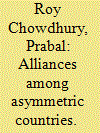

|
|
|
|
|
| Publication |
2007.
|
| Summary/Abstract |
We examine alliances between asymmetric countries. We find that the results depend on the nature of the equilibrium. If the equilibrium is an interior one then, with an increase in asymmetry, the level of the alliance-wide defense good decreases and the divergence between the first best and the equilibrium level of the defense good increases. In the case where the equilibrium involves a corner solution, these results are reversed. It may be argued, however, that the interior equilibrium case is the more relevant one.
|
|
|
|
|
|
|
|
|
|
|
|
|
|
|
|
| 2 |
ID:
171441
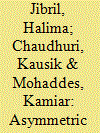

|
|
|
|
|
| Summary/Abstract |
We examine the asymmetric effects of oil supply shocks, shocks to global real economic activity, and oil-specific demand shocks on the oil, non-oil and overall trade balances of a large sample of oil exporters and oil importers. Our empirical strategy accounts for endogenous oil prices, heterogeneous parameters, and error cross section dependence within a panel framework. We find that the pattern of asymmetries in the oil price-trade balance relationship depends on the source of the shock. For both oil exporters and oil importers, oil supply expansions are more important than oil supply disruptions; we discuss the role that Saudi Arabia plays in limiting the global effects of oil supply disruptions. Although increases in global demand deteriorate trade balances for oil importers and improve them for oil exporters, decreases in global demand have a similar, rather than an opposite effect. Our results corroborate the existing evidence that oil price increases only generate large global imbalances if they result from demand-side shocks; and we present new evidence that oil price decreases only benefit oil importers if they result from supply-side shocks.
|
|
|
|
|
|
|
|
|
|
|
|
|
|
|
|
| 3 |
ID:
088933


|
|
|
|
|
| Publication |
2009.
|
| Summary/Abstract |
This article addresses the conflict over the Euphrates and Tigris waters from the perspective of negotiation theories, by examining the role of power in upstream/downstream negotiations. Conceptual and empirical links are established between water, negotiation (structure, process), power (asymmetries, coalition dynamics, strategies, development of alternatives) and security (direct/indirect interests such as national security, border security, territorial claims, economic development and environmental concerns). The study concludes that asymmetries in power have favored upstream/downstream interactions towards bilateral if not basin-wide arrangements. The framework shows that traditional elements of power, such as upstream positions, military and economic resources, do not constitute the only sources of power. Bargaining power can also determine the dynamics between respective riparians. Time constitutes an important source of power, and interests vary over time when political settings and security concerns shift. Downstream or more vulnerable riparians can invert situations of power asymmetry by acting on the basin-dominant riparian's interests and thus reduce its alternatives. Syria's use of 'issue-linkage' in its interactions with Turkey over water and wider security issues serves as the primary example.
|
|
|
|
|
|
|
|
|
|
|
|
|
|
|
|
| 4 |
ID:
097832
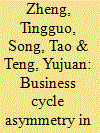

|
|
|
|
|
| Publication |
2010.
|
| Summary/Abstract |
Friedman's plucking model of business fluctuations suggests that output cannot exceed an upper limit, but it is occasionally "plucked" downward below trends as a result of economic recessions. This paper investigates China's business fluctuations using quarterly real GDP data for the period 1978-2009. Our results show some evidence supporting Friedman's plucking model. We find that a ceiling effect of real output exists, and that negative asymmetric shocks significantly affect the transitory component, which captures the plucking downward behavior during the recession. The results also suggest that the basic asymmetric unobserved component model is not appropriate for directly modeling China's real output because the business cycle is inaccurately measured, but it works quite well when considering a structural break in the second quarter of 1992. The results reveal that although China's economy strengthened in the second quarter of 2009, it is essential for China's government to take further positive and effective measures to maintain sustainable development of the economy.
|
|
|
|
|
|
|
|
|
|
|
|
|
|
|
|
| 5 |
ID:
092582
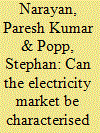

|
|
|
|
|
| Publication |
2009.
|
| Summary/Abstract |
In this paper, we test for asymmetric behaviour of industrial and residential electricity demand for the G7 countries, using the entropy-based test for symmetry suggested by [Racine, J., and Maasoumi, E., 2007. A versatile and robust metric entropy test of time-reversibility, and other hypotheses. Journal of Econometrics 138(2), 547-567; Racine, J., and Maasoumi, E., 2008. A robust entropy-based test of asymmetry for discrete and continuous processes. Econometric Reviews 28, 246-261], the Triples test of [Randles, R., Flinger, M., Policello, G., and Wolfe, D., 1980. An asymptotically distribution-free test for symmetry versus asymmetry. Journal of the American Statistical Association 75, 168-172] and the [Bai, J., and Ng, S., 2001. A consistent test for conditional symmetry in time series models. Journal of Econometrics 103, 225-258] test for conditional symmetry. Using data that spans over three decades, we find overwhelming evidence of conditional symmetry of residential and industrial electricity consumption. This finding implies that the use of econometric tests based on linear data generating processes is credible.
|
|
|
|
|
|
|
|
|
|
|
|
|
|
|
|
| 6 |
ID:
191904
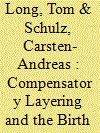

|
|
|
|
|
| Summary/Abstract |
International organizations come in many shapes and sizes. Within this institutional gamut, the multipurpose multilateral intergovernmental organization (MMIGO) plays a central role. This institutional form is often traced to the creation of the League of Nations, but in fact the first MMIGO emerged in the Western Hemisphere at the close of the nineteenth century. Originally modeled on a single-issue European public international union, the Commercial Bureau of the American Republics evolved into the multipurpose, multilateral Pan American Union (PAU). Contrary to prominent explanations of institutional genesis, the PAU's design did not result from functional needs nor from the blueprints of a hegemonic power. Advancing a recent synthesis between historical and rational institutionalism, we argue that the first MMIGO arose through a process of compensatory layering: a mechanism whereby a sequence of bargains over control and scope leads to gradual but transformative institutional change. We expect compensatory layering to occur when an organization is focal, power asymmetries among members of that organization are large, and preferences over institutional design diverge. Our empirical and theoretical contributions demonstrate the value a more global international relations (IR) perspective can bring to the study of institutional design. international relations (IR) scholars have long noted that international organizations provide smaller states with voice opportunities; our account suggests those spaces may be of smaller states’ own making.
|
|
|
|
|
|
|
|
|
|
|
|
|
|
|
|
| 7 |
ID:
145693
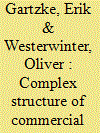

|
|
|
|
|
| Summary/Abstract |
Researchers continue to debate the impact of trade on interstate conflict. While many view trade as pacifying, others argue that dependencies increase friction and the risk of war. We provide a theory that explains how cross-border economic ties alternately enhance or impede international cooperation. Three main factors account for the heterogeneous effects of trade on conflict: interdependence, asymmetry, and multipolarity. Interdependence can act as a substitute for, or as a deterrent to, militarized violence. In the former case, interdependence actually increases more modest non-militarized conflict, while also discouraging militarized disputes. Asymmetry diminishes the conflict-inhibiting effect of trade ties, as dependency cannot simultaneously be used to coerce and to inform. Multilateral trade networks alternately moderate or enhance the bilateral effects of interdependence and asymmetry on interstate peace. Our theory and evidence reveal complex, cross-cutting consequences of economic interdependence on conflict behavior and also demonstrate effects well beyond the dyad, suggesting the need to include extradyadic ties in future theoretical and empirical research studying the commercial peace.
|
|
|
|
|
|
|
|
|
|
|
|
|
|
|
|
| 8 |
ID:
084349


|
|
|
|
|
| Publication |
2008.
|
| Summary/Abstract |
Third-party actors who mediate or monitor peace often strive to uphold an image of neutrality. Yet, they commonly face accusations of partiality. The Nordic engagement in the Sri Lankan peace process is an illustration of this puzzle: despite the efforts to uphold an image of being neutral mediators and monitors, they have been seen as favoring one side or the other. This article suggests that part of the explanation for their failure to be seen as neutral lies in the fact that armed conflicts are characterized by certain asymmetries between the main antagonists - in capabilities, status and behavior. These imbalances pose particular challenges to the third party aspiring to act in a neutral manner. We suggest that third parties have two strategies available to deal with imbalances in the relationship between the contenders: 1) they can choose to disregard the asymmetrical relationship and act in an even-handed manner or 2) they can seek to counterbalance the lopsidedness. This article explores the dynamics of these strategies by analyzing the Nordic involvement in Sri Lanka's peace process that began in 2002.
|
|
|
|
|
|
|
|
|
|
|
|
|
|
|
|
| 9 |
ID:
156555
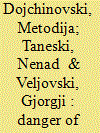

|
|
|
|
|
| Summary/Abstract |
The term “hybrid warfare” is a new one that the West began to use to explain its failure to cope with asymmetric threats. Focusing on the war on global terrorism, the West temporarily withdrew its attention from traditional adversaries, such as Russia, which has used this gap and has audaciously returned to the stage as a global actor. Until the Russian annexation of the Crimean Peninsula in 2014 and inflaming the Ukrainian crisis, most Western authors attributed “hybrid threats” mostly to non-state actors. But the Ukrainian scenario showed the true face of “hybridity” in the modern battlefield when practised by a powerful state actor. Russian “hybrid warfare” in Ukraine has already been seen as a combination of conventional and unconventional methods, that have been complemented with other instruments of national power – diplomatic, economic and information. The purpose of this article is, through an analysis of the Ukrainian scenario, to demonstrate that although the term “hybrid” is new, the concept itself is old and is a continuation of already seen doctrine from the Cold War era. Although “hybrid threats” can come both from state and non-state actors, the Russian interference in Ukraine is proof that they are especially dangerous for the West if, or when, they are initiated from a traditional, sophisticated adversary that has the capacity to use all forms of warfare.
|
|
|
|
|
|
|
|
|
|
|
|
|
|
|
|
| 10 |
ID:
121731
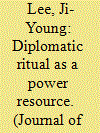

|
|
|
|
|
| Publication |
2013.
|
| Summary/Abstract |
What explains Korea's success in surviving as an independent state for over 2,000 years, not annexed to China, when it shares a border with this powerful imperial neighbor? I argue that diplomatic ritual can be conducive to managing asymmetric power relations and that the Korean state and the Chinese state prior to the nineteenth century used the diplomatic ritual of investiture in a strategic manner as a signaling mechanism to manage the expectations of each side. Drawing insights from ritual studies, I offer three specific mechanisms: (1) regularity and precision, (2) strategic ambiguity, and (3) the manipulation of symbols, through which the ritualization of power relations reduces the tension arising from the disparity in power. The empirical evidence comes from an investigation of a total of sixteen investiture cases between Choso n Korea and Ming China between 1392 and 1644. It shows that the granting and seeking of investiture on both sides was not only a way of signaling their commitment to the status quo, but also a medium of negative soft power through which the stronger side could change the status quo relations to its favor using the symbolic power embedded in the investiture ritual.
|
|
|
|
|
|
|
|
|
|
|
|
|
|
|
|
| 11 |
ID:
133046
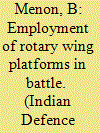

|
|
|
|
|
| Publication |
2014.
|
| Summary/Abstract |
Apart from other roles, insurgencies in Malaya, Kenya, Zimbabwe, French lndo-China and Algeria saw helicopters being used for troop induction into and extraction from combat zones, rudimentary fire support to ground forces and surveillance. Most operations were confined to daytime and in relatively clear weather due to equipment limitations. In almost all scenarios, there was a marked asymmetry in terms at technology and equipment in favour of conventional forces. Some success in these operations led to the assumption that with the added advantages oi hover capability helicopters were relatively invulnerable when compared to fixed wing aircraft.
|
|
|
|
|
|
|
|
|
|
|
|
|
|
|
|
| 12 |
ID:
155101
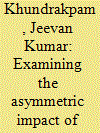

|
|
|
|
|
| Summary/Abstract |
Though an accumulating body of work has analysed monetary policy transmission in India, there are few studies examining the asymmetric aspect of the transmission. Against this backdrop, segregating the interest rate setting process captured by a Taylor rule type into unanticipated and anticipated components, this article analyses the asymmetric effects of monetary policy on aggregate demand and its components, and inflation in India using quarterly data from 1996–97Q1 to 2013–14Q3. It finds that unanticipated hikes and cuts in the policy rate have a symmetric impact on aggregate demand, but differentially impact the components. While the impacts on investment are negative and symmetric, they are asymmetric on private consumption, with only an unanticipated cut in policy rate having a significant negative impact. Government consumption is unaffected by monetary policy shocks. The impact of unanticipated interest rate changes on inflation is negative and symmetric. Anticipated policy rate changes also have a negative impact on aggregate demand and its components, except for government consumption, but between certain levels, such changes are ineffective, indicating a neutral impact. Anticipated policy rate changes have a negative impact on inflation at all levels.
|
|
|
|
|
|
|
|
|
|
|
|
|
|
|
|
| 13 |
ID:
178859
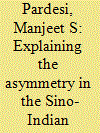

|
|
|
|
|
| Summary/Abstract |
China views India as an asymmetric (‘lesser’) rival that has the ability to obstruct China’s grand strategic goals. China’s long-term goals are domination in East Asia followed by Asia-wide domination, and finally global pre-eminence. The asymmetric dimension of their rivalry is rooted in the ego-relevancy cognitive bias in the Chinese elites’ perceptions of Indian history and statehood. Consequently, China does not consider India as a ‘peer’. This perceptual dimension pre-dates their material power asymmetry. Nevertheless, China perceives India as an ‘imperial’ rival that interferes in China’s Tibet. Furthermore, India’s ‘hegemonic’ ambitions in Southern Asia pose a challenge for China at the pan-Asian level, and may even undermine Chinese domination in East Asia. Thus understood, there are three implications for the Sino-Indian rivalry. First, the positional and territorial dimensions of their rivalry are now intertwined and will be difficult to resolve. Second, this is not just a dyadic rivalry as it will interact with their relations with the United States, Japan, and Pakistan, thereby creating new uncertainties. Finally, the military undertones of this rivalry are spilling over into other regional countries. This rivalry will intensify if India pursues internal or external balancing, or if India charts a distinct path to politico-economic modernisation.
|
|
|
|
|
|
|
|
|
|
|
|
|
|
|
|
| 14 |
ID:
095429
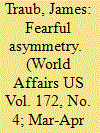

|
|
|
|
|
| Publication |
2010.
|
| Summary/Abstract |
In the first minutes of Israel's assault on Gaza on December 27, 2008, F-16s fired missiles into the police headquarters and three police stations, killing ninety-nine policemen (and nine civilians). Israel viewed Gaza's police as an ancillary wing of Hamas, the political and military force which governs Gaza, to be mobilized as soldiers in times of war. The wave of attacks thus constituted a preemptive strike at Hamas's military infrastructure. Israeli strikes would kill a total of 248 members of Gaza's police force in the course of the Cast Lead operation. But these men were, in fact, policemen; had Israel not invaded Gaza that day, many would have gone off to direct traffic and do the other things police officers do elsewhere. Were they civilians or were they combatants? The report of the U.N. Fact Finding Mission on the Gaza Conflict, known as the Goldstone Report (after Richard Goldstone, the South African jurist who served as chief investigator), concluded that the attack on the police stations violated principles of international humanitarian law, which require those who wage war to minimize harm to civilians. The report cites the attack as only one of many instances where the Israel Defense Forces (IDF) may have committed war crimes.
|
|
|
|
|
|
|
|
|
|
|
|
|
|
|
|
| 15 |
ID:
168266
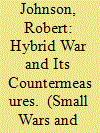

|
|
|
|
|
| Summary/Abstract |
This article examines critically the literature of hybrid war and evaluates the countermeasures often proposed. It explains the concept of hybrid warfare and its varied interpretations, illustrating how it is a manifestation of current anxieties in armed conflict. The selection of the literature is based on works that are referenced, that offer a scientific approach, and which review either the phenomenon of hybrid warfare or its countermeasures empirically. Unscientific works have been omitted. The analysis of the literature presented here shows that the antidotes to ‘hybridity’ lie not in the operational or tactical sphere but in strategic and political domains.
|
|
|
|
|
|
|
|
|
|
|
|
|
|
|
|
| 16 |
ID:
140190
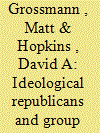

|
|
|
|
|
| Summary/Abstract |
Scholarship commonly implies that the major political parties in the United States are configured as mirror images to each other, but the two sides actually exhibit important and underappreciated differences. The Republican Party is primarily the agent of an ideological movement whose supporters prize doctrinal purity, while the Democratic Party is better understood as a coalition of social groups seeking concrete government action. This asymmetry is reinforced by American public opinion, which favors left-of-center positions on most specific policy issues yet simultaneously shares the general conservative preference for smaller and less active government. Each party therefore faces a distinctive governing challenge in balancing the unique demands of its base with the need to maintain broad popular support. This foundational difference between the parties also explains why the rise of the Tea Party movement among Republicans in recent years has not been accompanied by an equivalent ideological insurgency among Democrats.
|
|
|
|
|
|
|
|
|
|
|
|
|
|
|
|
| 17 |
ID:
160349
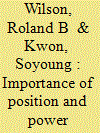

|
|
|
|
|
| Summary/Abstract |
This paper analyzes how U.S. foreign policy, based on symmetry or asymmetry,
drives international relations, and can lead to positive or negative state-to-state
relations. The paper uses the case of U.S. foreign policy towards North Korea to
discuss the importance of position and power when dealing with societies and
nations. The paper discloses that U.S. foreign policy approach towards North Korea
has not significantly evolved over the past 60 years regardless of administration
and that the current paradigm of dealing with complex state-to-state issues only
works to sustain negative relations. The paper further finds that the continued
negative relations and deep-rooted and protracted conflict between the United States
and North Korea is intimately connected to the way in which the United States
handles state-to-state relationships. On the basis of these observations, the paper
recommends alternative multi-dimensional foreign policy approaches based on
conflict analysis and resolution methods and tools needed to successfully transform
the relationship and build sustainable peace with North Korea and in the East Asia
Region.
|
|
|
|
|
|
|
|
|
|
|
|
|
|
|
|
| 18 |
ID:
113257
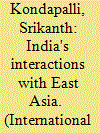

|
|
|
|
|
| Publication |
2010.
|
| Summary/Abstract |
India's relations with countries of East Asia reveal its growing profile in the region in economic, technological, diplomatic, political and military spheres. India's Look East policy, initiated in 1992, is bearing fruit now, as seen in the region becoming the largest trading partner of India, enhanced bilateral and multilateral diplomatic interactions, and long-term commitments in the security (maritime, cyber and space) fields. No doubt, relations between India and East Asia are acquiring depth as reflected in the broad-based interactions at the bilateral and multilateral levels as well as in trade, investments and people-to-people contacts in recent years. While Japan and both Koreas pose no major hurdle to India's foreign policy goal of garnering support for its basic cause of territorial integrity and sovereignty, the equation with China presents a very complicated picture. The apparent lack of insistence on the reciprocity principle by India in its dealings with China reflects the growing asymmetries in power between the two. As a result, India has been trying to enhance its defence cooperation with South Korea and Japan.
|
|
|
|
|
|
|
|
|
|
|
|
|
|
|
|
| 19 |
ID:
160017
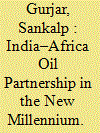

|
|
|
|
|
| Summary/Abstract |
The nature of relationship between India–Africa has been simultaneously asymmetric as well as complementary. It is reflected in Indo-African oil relationship. In this oil relationship, India and Africa gain and loose at different period of time depending on the global oil prices. Higher oil prices put India at a disadvantageous position, whereas lower oil prices are not beneficial for oil producing and exporting states of Africa. Over the years, India has built oil ties, among others, with Nigeria, Sudan, South Sudan and Angola. By and large, Indo-African oil relations have witnessed a steady progress and gradual expansion in the new millennium. India’s quest for oil in Africa faces difficult challenge from China. In all likelihood, India’s rising oil demand and quest to diversify oil basket, geographically, will further strengthen the India–Africa oil relations.
|
|
|
|
|
|
|
|
|
|
|
|
|
|
|
|
| 20 |
ID:
193237
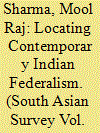

|
|
|
|
|
| Summary/Abstract |
Indian federalism is a peculiar model designed to accomplish the necessities of a heterogeneous and multifaceted society. The constitutional framework of federalism spells out that the fate of the states rests with the centre, as the centre can alter it with consultation but without taking consent from the concerned states. The justification offered for such a design during the Constituent Assembly deliberations was to thwart the centrifugal forces that had caused the partition of the subcontinent. The post-independence issues emerged due to several circumstances that influenced federalism in a political milieu where one party, the Congress, held dominance for the first two decades. This phase of Indian federalism was less contentious than the subsequent phase because of consensual politics but opposition and confrontation later appeared with the rise of oppositional politics and regional autonomy demands. In the 1990s, Indian federalism experienced a shift where regionalisation and federalisation of political parties reshaped the federal context along with other factors. Also, this was a volatile phase followed by a bi-nodal alliance system that brought political stability at the national level. The BJP scripted landmark victories in the 2014 and 2019 Lok Sabha elections that unleashed new challenges and strengthened the trends of centralisation. Besides centralisation, federal cooperation found space through several initiatives of the centre. Thus, the article investigates how Indian federalism functions in a variegated system by emphasising the contemporary trends of centralisation with changing dynamics.
|
|
|
|
|
|
|
|
|
|
|
|
|
|
|
|
|
|
|
|
|